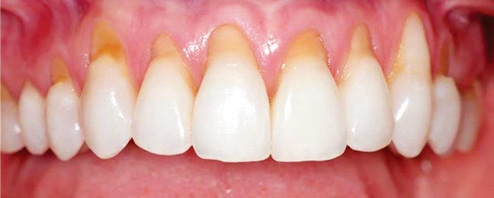Gum Disease
What is Gum Disease?
Inflamed, bleeding gums, bad breath, and gum recession are common signs of gingivitis and gum disease. Gum disease is caused by bacteria in periodontal pockets, deep in the gum tissue down to the tooth roots. Routine hygiene, such as brushing and flossing, helps to get rid of plaque, but if the plaque solidifies and forms tartar, brushing and flossing will not remove it. The professional skills of dentists or dental hygienists are required to regularly perform cleaning treatments to remove this tartar.

Not just gum disease, it’s your health
If you have been told that you have gum disease, you are not alone. Nearly 70% of adults have some form of gum disease. The most important thing to know about gum disease is that you shouldn’t ignore it.
Left untreated, gum disease will result in receding gums, bone loss, and ultimately may cost you your teeth. Additionally, studies show that periodontal disease is associated with heart disease, diabetes and cancer. So, if you have gum disease, it’s very important for your overall health that you get treatment.
Here are some warning signs:
Gums that bleed easily
Red, swollen, tender gums
Gums that have pulled away from the teeth
Persistent bad breath or bad taste
Permanent teeth that are loose or separating
Any change in the way your teeth fit together when you bite
Any change in the fit of partial dentures
Gum disease risk factors:
Poor oral hygiene
Smoking or chewing tobacco
Genetics
Crooked teeth that are hard to keep clean
Pregnancy/hormonal changes
Diabetes
Medications, including steroids, certain types of anti-epilepsy drugs, cancer therapy drugs, some calcium channel blockers and
oral contraceptives
Periodontal Therapy
Periodontal therapy can take various forms, but the goal is always to restore diseased tissues to health. Gum (periodontal) disease can spread from the gums to the bone that supports the teeth, and may even cause tooth loss in the most severe cases.
Periodontal Therapy Procedures
Periodontal therapy includes both surgical and non-surgical techniques to restore health to the tissues that support the teeth (gums and bone) and prevent tooth loss.
Scaling and Root Planing
Plaque and calculus (tartar) are removed from beneath the gum tissues, using hand scalers and/or ultrasonic instruments.
Periodontal Plastic Surgery
Reshaping procedure that creates a more pleasing appearance of the gum tissues.
Periodontal Laser Treatment
Removing diseased gum tissue with lasers with less discomfort and gum shrinkage.
Crown Lengthening Surgery
Tooth structure that is covered by gum and bone tissue is exposed either for cosmetic reasons or to aid in securing a new dental crown.
Dental Implants
One of today’s preferred methods of tooth replacement.
Gum Recession
Pinhole® Surgical Technique
SCALPEL FREE – SUTURE FREE – GRAFT FREE

The Chao Pinhole® Surgical Technique (PST), is a scalpel-free, suture-free procedure for correcting gum recession.
Through a small hole made by a needle, specially designed instruments are used to gently loosen the gum tissue and glide it over the receded part of the tooth.
Since there is no cutting or stitching, patients can expect minimal post-operative symptoms.


Pinhole® Surgical Technique (PST) enhanced even further by utilising Platelet Rich Fibrin (PRF).
PRF is a big step forward in dental healing.
A small amount of blood is collected from you and processed chair side in about ten minutes, the PRF plug that is created contains your own regenerative stem cells, this PRF plug is used to help your own healing.

